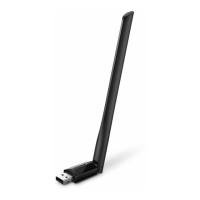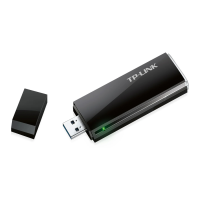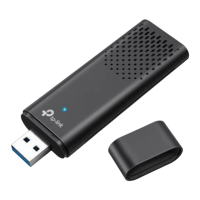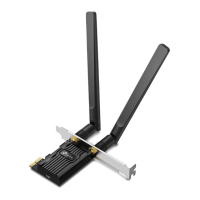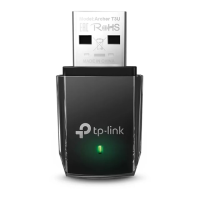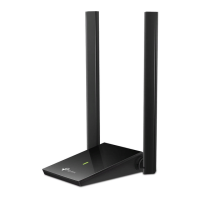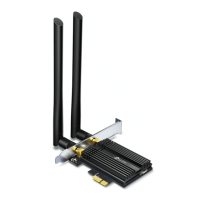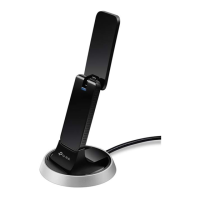Do you have a question about the TP-Link Archer T2U and is the answer not in the manual?
Details compliance with FCC radiation exposure limits for uncontrolled environments.
States compliance with Industry Canada license-exempt RSS standard(s) and operating conditions.
Provides warnings regarding radio interference potential for wireless equipment in Korea.
Contains notices and requirements from Taiwan's NCC and BSMI for wireless devices.
Overview of the dual band 802.11ac client device for high-speed wireless performance.
Details key features including IEEE 802.11ac compliance, USB 2.0, dual-band support, and security.
Instructions for physically connecting the wireless adapter to a computer's USB port.
Steps to connect to a wireless network using the TP-LINK Wireless Configuration Utility.
Manages saved wireless network configurations (profiles) for easy connection.
Instructions for uninstalling the TP-LINK utility and driver software on Windows XP and 7.
Details compliance with FCC radiation exposure limits for uncontrolled environments.
States compliance with Industry Canada license-exempt RSS standard(s) and operating conditions.
Provides warnings regarding radio interference potential for wireless equipment in Korea.
Contains notices and requirements from Taiwan's NCC and BSMI for wireless devices.
Overview of the dual band 802.11ac client device for high-speed wireless performance.
Details key features including IEEE 802.11ac compliance, USB 2.0, dual-band support, and security.
Instructions for physically connecting the wireless adapter to a computer's USB port.
Steps to connect to a wireless network using the TP-LINK Wireless Configuration Utility.
Manages saved wireless network configurations (profiles) for easy connection.
Instructions for uninstalling the TP-LINK utility and driver software on Windows XP and 7.
| Interface | WLAN |
|---|---|
| USB version | 2.0 |
| Connectivity technology | Wireless |
| Internal | No |
| Certification | CE, FCC |
| Component for | PC/Laptop |
| Product color | Black |
| LED indicators | Status |
| Receiver sensitivity | 5GHz:\\r 11a 6Mbps: -94dBm\\r 11a 54Mbps: -78dBm\\r 11n HT20 MCS0: -94dBm\\r 11n HT20 MCS7: -77dBm\\r 11n HT40 MCS0: -92dBm\\r 11n HT40 MCS7: -74dBm\\r 11ac VHT80 MCS0: -89dBm\\r 11ac VHT80 MCS9: -64dBm\\r 2.4GHz:\\r 11b 1Mbps: -99dBm\\r 11b 11Mbps: -91dBm\\r 11g 6Mbps: -94dBm\\r 11g 54Mbps: -77dBm\\r 11n HT20 MCS0: -95dBm\\r 11n HT20 MCS7: -76dBm\\r 11n HT40 MCS0: -92dBm\\r 11n HT40 MCS7: -73dBm |
| Modulation | 16-QAM, 256-QAM, 64-QAM, CCK, DBPSK, DQPSK, OFDM |
| Wi-Fi band | Dual-band (2.4 GHz / 5 GHz) |
| Frequency range | 2.4 - 5 GHz |
| Wi-Fi standards | 802.11a, Wi-Fi 5 (802.11ac), 802.11b, 802.11g, Wi-Fi 4 (802.11n) |
| Top Wi-Fi standard | Wi-Fi 5 (802.11ac) |
| Security algorithms | 128-bit WEP, 64-bit WEP, 802.1x RADIUS, WPA, WPA2, WPA2-AES, WPA2-PSK, WPA2-TKIP, WPS |
| Networking standards | IEEE 802.11a, IEEE 802.11ac, IEEE 802.11b, IEEE 802.11g, IEEE 802.11n, IEEE 802.3ac |
| Maximum data transfer rate | 600 Mbit/s |
| WLAN data transfer rates supported | 11, 54, 150, 433, 600 Mbit/s |
| Mac operating systems supported | macOS |
| Windows operating systems supported | Windows 10, Windows 7, Windows 8, Windows 8.1, Windows XP |
| Sustainability certificates | RoHS |
| Storage temperature (T-T) | -40 - 70 °C |
| Operating temperature (T-T) | 0 - 40 °C |
| Storage relative humidity (H-H) | 5 - 90 % |
| Operating relative humidity (H-H) | 10 - 90 % |
| Quantity | 1 |
| Package depth | 128 mm |
| Package width | 138 mm |
| Package height | 30 mm |
| Package weight | 90 g |
| Harmonized System (HS) code | 85176990 |
| Depth | 19.7 mm |
|---|---|
| Width | 40.5 mm |
| Height | 10.3 mm |


